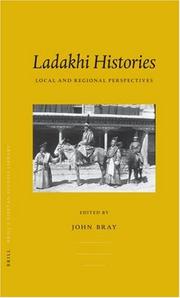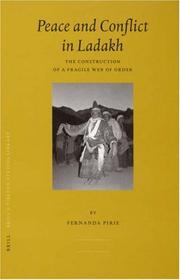| Listing 1 - 4 of 4 |
Sort by
|
Book
ISSN: 15686183 ISBN: 1283060949 9786613060945 9047443349 9789047443346 9789004167131 9004167137 9781283060943 6613060941 Year: 2008 Volume: 20 Publisher: Leiden ; Boston : Brill,
Abstract | Keywords | Export | Availability | Bookmark
 Loading...
Loading...Choose an application
- Reference Manager
- EndNote
- RefWorks (Direct export to RefWorks)
The modern history of Ladakh has been profoundly shaped by influences from South Asia and beyond. In detailed empirical case-studies the contributors document and analyse change and continuities in this region brought about by colonialism, independence and modernisation. In an introductory review essay highlighting emerging themes and continuing debates in the scholarship on Ladakh, the editors argue for the need to situate Ladakh in an Indian and South Asian context, while also taking into account its cultural, linguistic and historical ties with Tibet. Studies from the neighbouring (sub)regions of Kargil, Ladakh, Zangskar and Baltistan are brought together to make an important contribution to the anthropological and sociological literature on development and modernity, as well as to Ladakh, Tibetan and South Asian studies.
Ladakhi (South Asian people) --- Ladaki (South Asian people) --- Ethnology --- Social conditions. --- Ladākh (India) --- La-dwags (India) --- Ladākh District (India) --- Ladākh Tahsil (India) --- Laddākha (India) --- Laddakh (India) --- Social conditions --- Ladākh (India) --- Ladakhi (South Asian people) - Social conditions --- Ladakhi (South Asian people) - Case studies --- Ladākh (India) - Social conditions --- Union Territory of Ladākh (India)

ISBN: 1280868562 9786610868568 142942740X 9047408098 1433705265 9781429427401 9781433705267 9004145516 9789004145511 9781280868566 6610868565 9789047408093 Year: 2005 Publisher: Leiden ; Boston : Brill,
Abstract | Keywords | Export | Availability | Bookmark
 Loading...
Loading...Choose an application
- Reference Manager
- EndNote
- RefWorks (Direct export to RefWorks)
Ladakh's geographic location between the Himalaya and Karakoram mountains has exposed it to competing political and cultural influences from India, Central Asia and Tibet. This book points to Ladakh's distinct local identity, but argues that its historical development can best be understood in a wider regional perspective. It contains twenty-five research papers from the International Association of Ladakh Studies (IALS), and draws on contributions from historians, art historians, linguists and anthropologists. Their sources include Ladakhi historical documents, comparative linguistic research, visual evidence from temple architecture and inscriptions, Mughal biographies, European travel accounts, government records, trade receipts, and local oral tradition. Taken together, the volume provides a much richer view of Ladakhi history than was previously available, and makes a significant contribution to the study of the wider Himalayan region.
Ladākh (India) --- La-dwags (India) --- Ladākh District (India) --- Ladākh Tahsil (India) --- Laddākha (India) --- Laddakh (India) --- History. --- Collection of essays. --- Annals --- Auxiliary sciences of history --- Union Territory of Ladākh (India) --- Ladakh (India)

ISBN: 1281458201 9786611458201 9047411811 9789047411819 9789004155961 9004155961 9781281458209 6611458204 Year: 2007 Publisher: Leiden ; Boston : Brill,
Abstract | Keywords | Export | Availability | Bookmark
 Loading...
Loading...Choose an application
- Reference Manager
- EndNote
- RefWorks (Direct export to RefWorks)
Long caught between powerful neighbours, Ladakh is now a border region in the vast Indian nation state. In this detailed, anthropological study Fernanda Pirie traces the ways order has been created by, but also despite and in defiance of, the powerful external forces of religion, war, politics and wealth. Gradually a clear analysis unfolds of the subtle dynamics that have long characterised relations between local communities and centres of power and which can successfully be applied to the wider region. This exemplary study of conflict resolution brings to light the means by which small communities, both rural and urban, negotiate peace amidst the heterogeneous forces of modernity, while at the same time critically re-examining theories that over-emphasize the explanatory power of Buddhism. This rich ethnographic account of local practices fills a conspicuous gap in secondary literature on Tibetan law.
Ladākh (India) --- La-dwags (India) --- Ladākh District (India) --- Ladākh Tahsil (India) --- Laddākha (India) --- Laddakh (India) --- Boundaries. --- Politics and government. --- Social life and customs. --- Union Territory of Ladākh (India) --- Ladakh (India)

ISBN: 9780511610943 9780521830003 9780521536820 0511185197 9780511185199 0511187882 9780511187889 0521830001 0521536820 0511186959 9780511186950 0511186029 9780511186028 0511610947 9786610457748 6610457743 1107148014 1280457740 0511313861 9781107148017 9781280457746 9780511313868 Year: 2004 Publisher: Cambridge ; New York : Cambridge University Press,
Abstract | Keywords | Export | Availability | Bookmark
 Loading...
Loading...Choose an application
- Reference Manager
- EndNote
- RefWorks (Direct export to RefWorks)
Andrea Wiley investigates the ecological, historical, and socio-cultural factors that contribute to the peculiar pattern of infant mortality in Ladakh, a high-altitude region in the western Himalayas of India. Ladakhi newborns are extremely small at birth, smaller than those in other high-altitude populations, smaller still than those in sea level regions. Factors such as hypoxia, dietary patterns, the burden of women's work, gender, infectious diseases, seasonality, and use of local health resources all affect a newborn's birth weight and raise the likelihood of infant mortality. An Ecology of High-Altitude Infancy is unique in that it makes use of the methods of human biology but strongly emphasizes the ethnographic context that gives human biological measures their meaning. It is an example of a new genre of anthropological work: 'ethnographic human biology'.
Medical anthropology --- Infants --- Altitude, Influence of --- Human ecology --- Ecology --- Environment, Human --- Human beings --- Human environment --- Ecological engineering --- Human geography --- Nature --- Acclimatization --- Atmospheric pressure --- Medical climatology --- Babies --- Infancy --- Children --- Medical care --- Medicine --- Anthropology --- Mortality --- Social aspects --- Effect of environment on --- Effect of human beings on --- Physiological effect --- Anthropological aspects --- Ladākh (India) --- Environmental conditions. --- La-dwags (India) --- Ladākh District (India) --- Ladākh Tahsil (India) --- Laddākha (India) --- Laddakh (India) --- Social Sciences --- Union Territory of Ladākh (India) --- Ladakh (India)
| Listing 1 - 4 of 4 |
Sort by
|

 Search
Search Feedback
Feedback About UniCat
About UniCat  Help
Help News
News